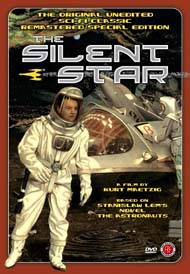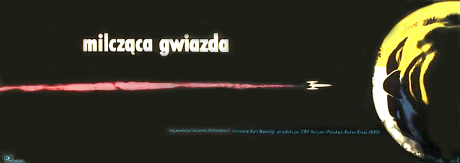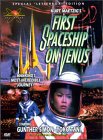| Release List | Reviews | Price Search | Shop | Newsletter | Forum | DVD Giveaways | Blu-Ray/ HD DVD | Advertise |
| Reviews & Columns |
|
Reviews DVD TV on DVD Blu-ray International DVDs Theatrical Reviews by Studio Video Games Features Collector Series DVDs Easter Egg Database Interviews DVD Talk TV DVD Talk Radio Feature Articles Columns Anime Talk DVD Savant HD Talk Horror DVDs Silent DVD
|
DVD Talk Forum |
|
|
| Resources |
|
DVD Price Search Customer Service #'s RCE Info Links |
|
Columns
|
 |
The Silent Star |

|
The Silent Star First Run Films 1960 / Color / 2:35 flat letterbox / 95 min. / Der Schweigende Stern, First Spaceship on Venus, Milczaca gwiazda, Planet of the Dead, Raumschiff Venus antwortet nicht / Street Date August 23, 2005 / 24.95 Starring Yoko Tani, Oldrich Lukes, Ignacy Machowski, Julius Ongewe, Michail N. Postnikow, Kurt Rackelmann, Günther Simon, Tang Hua-Ta Cinematography Joachim Hasler Production Designer Alfred Hirschmeier Film Editor Lena Neumann Original Music Andrzej Markowski Written by Wolfgang Kohlhaase, Günter Reisch, Kurt Maetzig, Jan Fethke, Günther Rücker, Alexander Stenbock-Fermor from the 1951 novel Astronauci by Stanislaw Lem Produced by Hans Mahlich, Edward Zajicek Directed by Kurt Maetzig |
Almost exactly five years ago, Savant reviewed the Image release of the 1962 Crown-International 'Americanized' version of First Spaceship on Venus. The essay grew rather lopsided as I revised it with additional information from helpful friends like Andreas Kortmann. A year or so later a Region 2 PAL disc of the original East German-Polish version Der Schweigende Stern (The Silent Star) was released. It was fifteen minutes longer but didn't have English subtitles, so the contents of the additional dialogue scenes remained a mystery. Just last year, a special DVD produced as a teaching supplement at Amherst College raised a few eyebrows -- it had a fantastic set of extras but was priced like a textbook, marked up to $180.00!
Now First Run Films is releasing an authorized Region 1 disc with English subs and a modest but interesting selection of extras. And although the basic plot and technical details of this Socialist flight to Venus are the same, the original script has a vastly different ideological underpinning. This more accessible release will settle some questions while raising others. The Silent Star also went under the name Spaceship Venus Does Not Answer when the chopped-down American cut was re-imported into West Germany. There never was a 130-minute cut, as reported in some texts. According to the (reliable?) liner notes on this new disc, the original Soviet Bloc version was filmed in 70mm.
Avoiding a meteor storm, the Cosmokrator lands on a bleak Venus of weird and unfamiliar sights. Brinkman discovers a cave infested with metallic insects, which Sikarna determines is an archive of recorded data. A metallic forest is a tangle of radioactive trees that once functioned as some kind of energy-projecting weapon. Like everything else on Venus, it appears to have been partially destroyed in a nuclear holocaust, a theory borne out when shadows of Venusians are seen burned into a wall, Hiroshima-style. Just as the explorers realize that Venus destroyed itself while preparing to invade Earth, a chain reaction of events throws their plans into chaos. A black & red ooze pursues Omigura, Brinkman and Soltyk up the spiral ramp of a conical structure. In desperation, Soltyk fires a ray gun at it, a move that saves the trio but upsets the balance of the giant machines that still function on the dead planet. The scientists discover that an underground power plant is augmenting gravity with a force field. To allow the Cosmokrator to blast off, Talua and Tchen Yu enter the plant to reverse the process. Tchen Yu's spacesuit is punctured, so Brinkman pilots a mini-rocket in a rescue attempt. Talua's efforts succeed in reversing the gravitation, which then swings to the opposite extreme -- negative gravity. The Cosmokrator is forced off the planet, while Brinkman's tiny rocket is tossed into the void. Poor Talua is marooned on the surface. Back home, the five survivors mourn their lost comrades but deliver a sober lesson about a world whose fate the Earth will hopefully not share.
In 1960 all the positive space travel news was coming from behind the Iron Curtain. Neither Russians nor the US had yet gotten a man into orbit. Our rockets were noted mostly for blowing up on the launch pad while the tight lid on information from the USSR made every effort at Star City seem a smashing success. So it was obviously with no small amount of pride that this expensive DEFA production foresaw an international space program conquering the heavens while the United States lagged far behind.
The source novel by Stanislaus Lem (author of Solaris) offered a general warning of atomic war, and the famous Polish writer didn't think much of the movie version. One might surmise that Communist Party ideologues made sure the film sent the right messages, for not a scene goes by without a nugget of wisdom (or four) about the folly of American aggression and the glory of cooperation between brother nations working in a common cause. In other words, by American standards this original version is 100% Soviet propaganda. We were told a lot about propaganda during the official years of the Cold War. The Silent Star lets us see it in action, completely dominating a genre thriller. The political posturing of 1950s Science Fiction thrillers has remained the genre's most interesting aspect.

Most every speech in Silent Star not devoted to necessary plot and technical exposition is devoted to party doctrine. It finds a place in every scene, sometimes in interesting ways. The harmonious 'world government' is able to bring together a dream team of experts from Japan, India, China, Africa, Poland, East Germany and the Soviet Union. The desired American nuclear physicist Dr. Hawling (renamed Harringway in the Crown-International re-cut) hasn't been able to respond to the Communist invitation to join in the expedition because of objections by New York businessmen. "My dream is the stars," he tells an older scientist, "Not your old dream, which was Hiroshima." Another presumably Jewish German expatriate scientist talks of fleeing Hitler and then being coerced into making bombs. America, the film implies, is the prisoner of its aggressive policies and the enemy of freedom -- Hawling's little boy draws pictures of spaceships going to the stars, but Wall Street is only interested in selling weapons.
Hawling abandons his capitalist friends and is flown by the East German hotshot pilot Brinkman to the space center in the mountains of Germany. The original cut gives this beautiful location more screen time -- Brinkman and Hawley share a chat in an Alpine meadow that would be suitable for the opening of The Sound of Music. In the Crown re-cut Brinkman is identified as an American, even though he enters flying a Russian MIG fighter jet!
During the flight the crew relationships remain professional with just two exceptions. Hawling keeps losing games of chess to Soltyk's unbeatable robot Omega, so Soltyk adjusts Omega's circuits to allow the American to win. The inference is that a good way to keep those egotistical, competitive Yanks happy is to help them maintain the illusion that they're winners.
Brinkman repeatedly tries to re-ignite his romance with Sumiko; she rejects him with tragic memories of her husband's death on a lunar mission. She also brings up Hiroshima at least five times, referring to the loss of her family and her inability to have children due to the lingering radiation. She's the one who points out the only images left of the extinct Venusians -- their shadows left on walls from the atomic blast that destroyed the planet. The movie repeatedly refers to Hiroshima as proof of U.S. barbarity.
The general impression left by Silent Star is that Soviet spacemen are committed to science and the noble quest for the stars, whereas the Americans just want to put weapons into orbit and claim the heavens as their exclusive property. The Cold War suspicion, militarism and destructive rivalry were faults of both sides -- and the reckless Soviets suffered terrible unpublicized space accidents in their haste to beat the Americans. Only now are we seeing real cooperative joint ventures in space, a better outcome than that predicted by either country's Science Fiction movies. Even Stanley Kubrick in 2001: A Space Odyssey assumed that the Cold War would be a perpetual state of affairs.

The trailer for The Silent Star proudly proclaims that this is the first movie about the exploration of space, which is of course not true. It also flubs one of the cast names. The "... Antwortet Nicht" alternate title echoes not only the 1930s sci-fi thriller Floating Platform One Does Not Answer, but also the retitling of the 1955 Universal space-war classic This Island Earth, which was known in West Germany as Metaluna Does Not Answer. As he is dying, Sumiko tells Dr. Tchen Yu that the seeds he has planted have sprouted, a bit of business borrowed from the 1955 Paramount film Conquest of Space. Conquest is also obsessed with WW2, but in a completely nonsensical way. Not only is Hiroshima not mentioned, Benson Fong's Japanese scientist places blame for the war on bad Japanese nutrition!
The Silent Star rehashes spaceflight clichés seen in American space operas of the 50s: The meteorite storm, the need for an EVA to repair part of the ship. Gender and racial attitudes aren't that much different than in American movies, as the female crew member is a doctor who spends most of her time dispensing liquid food to the cranky spacemen. The presence of the African spaceman seems progressive, but he also fills a 'service-oriented' crew position. A German actor plays the Indian spaceman, perhaps indicating the lack of a strong relationship between that new commonwealth and the Soviet bloc.
Even though Lem's original novel was written several years before, Silent Star seems to mirror MGM's 1956 Forbidden Planet in its investigation of an alien civilization that overreached and destroyed itself. Rocketship X-M, the very first space travel movie of the 1950s, discovered that the Martians had blown themselves up with atomic weapons, which is exactly what this film's clumsy Venusians did while trying to attack the Earth. Aggression is futile, says the subtext of Silent Star, and those malign Americans are always behind the threat of the bomb. This propaganda gets more than a bit thick after a while.
Did Eastern Europeans accept The Silent Star as easily as Americans accepted our anti-Communist propaganda? The film preaches a one-world, Peace Now message and points its finger disapprovingly at capitalist profiteers and warmongers. When we heard about foreign propaganda it was mostly in conjunction with films we weren't allowed to see, to wit, almost everything from behind the Iron Curtain. No wonder U.S. censors and Commie-hunters pounced on Hollywood movies that had pacifist themes or were critical of Western materialism. That's what our 'enemies' were turning out.
The late 50s saw many Soviet-bloc fantasy films imported and edited for American kiddie audiences, including animated fairy tales like The Snow Queen. Karel Zeman's fanciful Jules Verne story Vynalez Zkazy became The Fabulous World of Jules Verne. Roger Corman removed the original political content from Soviet movies and kept the special effect scenes, as in Battle Beyond the Sun. The Silent Star has unique design ideas in its fanciful spaceships and rover-type vehicles (one hovercraft is called an 'Elasticopter') and truly awesome landscapes melted and charred by atomic blasts. Groves of drooping pod-like buildings resemble huts in paintings of Hell by Hieronymous Bosch. Clusters of globes evoke photos of the first H-Bomb blast, which seemed to show giant blisters hovering over the bombing site. In its film techniques the show is closer to Metropolis than Forbidden Planet; there are few if any opticals, and mirrors and careful double exposures are used to superimpose moody oil-smear 'atmospheres' over the eerie Venusian landscapes.

Viewers who have only seen the 1962 Crown-International version will notice major aural and visual differences in the original film. The colors here are much brighter and the contrast less choked --- Talua's face is no longer a black blot, and the surface of the planet looks like powdered lava sprinkled with diamond dust instead of the black muck it resembles in Image's earlier American version. The voyage seems more relaxed, with several time jumps played out over slow-fade transitions. Pre-launch activities are much more elaborate. In addition to the expected longer dialogue scenes, we see Sumiko break out a high-tech surgery when Professor Arsenyev is accidentally run over by the robot tank Omega.
The soundtrack is more restrained, with the original German dubbing not always well matched to actors' lips. A stirring and mysterious music score under the main title becomes much less apparent later in the show, and is a far cry from the wall-to-wall needle-drop tracks jammed into the U.S. version by import-meister Hugo Grimaldi. Instead of crying a noble farewell to the disappearing Cosmokrator, in the U.S. cut Talua wails, "Don't leave me behind!" The American version removed the original final trucking shot showing dozens of hands joining together in Socialist solidarity. It's a very nice ending, so taking it out seems simply mean-spirited. People can't hold hands -- that's Pinko behavior!
First Run Features' DVD of The Silent Star is a welcome release with a few disappointments. First Run does not seem to understand 16:9 enhancement, for they list that feature on the package when the disc is a simple flat letterboxed transfer. With the English subs dipping below the image, it's difficult to watch the film on a widescreen monitor without cutting them off (some sets can compensate for this). The transfer is good but not exceptional. Colors are fine -- those weird oil superimpositions look much better now. The picture isn't all that sharp but is defined well enough to reveal plenty of wires and other effects details we aren't supposed to notice.
The liner notes for the film say it was shot in 70mm, which is entirely possible but not documented anywhere Savant could find. Totalvision, according to the Hayes Widescreen Movies book, was just a 35mm anamorphic process used for various European films, mostly sword 'n' sandal pictures. If it was 70mm, there are no changeover cues or other telltale evidence on the film to indicate a flat negative. Most of the effects appear to be do-able in the camera (the Schufftan process, double exposures). Only a couple of shots look as if they must be opticals, which might have not been possible in 70mm anyway outside of Hollywood. On the other hand, the image field is rather flat for a 'scope picture, and so is the depth of focus.
The best things to see right away in the extras are two newsreel snippets of the film in production, especially the impressive forced perspective launch site set. Unfortunately, none of the angles shows the film magazines on any of the cameras to give us an idea of the film gauge ... on the Ruscico disc for War and Peace we were given plenty of views of Soviet 70mm cameras, and they're very distinctive.
Text extras discuss the film (one essay is called Socialists in Space) and offer bios for key production personnel. Some set design artwork is included as well. Trailers for The Silent Star and two other DEFA science fiction films, Eolomea and In the Dust of Stars round out the package.
On a scale of Excellent, Good, Fair, and Poor,
The Silent Star rates:
Movie: Very Good
Video: Good but not 16:9 enhanced; the package text is incorrect
Sound: Excellent
Supplements: text essays and bios, East German newsreel excerpts
Packaging: Keep case
Reviewed: August 18, 2005
Review Staff | About DVD Talk | Newsletter Subscribe | Join DVD Talk Forum
Copyright © DVDTalk.com All rights reserved | Privacy Policy | Terms of Use
|
| Release List | Reviews | Price Search | Shop | SUBSCRIBE | Forum | DVD Giveaways | Blu-Ray/ HD DVD | Advertise |





